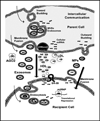Intercellular transport of microRNAs
- PMID: 23325475
- PMCID: PMC3580056
- DOI: 10.1161/ATVBAHA.112.300139
Intercellular transport of microRNAs
Abstract
Extracellular microRNAs (miRNA) are present in most biological fluids, relatively stable, and hold great potential for disease biomarkers and novel therapeutics. Circulating miRNAs are transported by membrane-derived vesicles (exosomes and microparticles), lipoproteins, and other ribonucleoprotein complexes. Evidence suggests that miRNAs are selectively exported from cells with distinct signatures that have been found to be altered in many pathophysiologies, including cardiovascular disease. Protected from plasma ribonucleases by their carriers, functional miRNAs are delivered to recipient cells by various routes. Transferred miRNAs use cellular machinery to reduce target gene expression and alter cellular phenotype. Similar to soluble factors, miRNAs mediate cell-to-cell communication linking disparate cell types, diverse biological mechanisms, and homeostatic pathways. Although significant advances have been made, miRNA intercellular communication is full of complexities and many questions remain. This review brings into focus what is currently known and outstanding in a novel field of study with applicability to cardiovascular disease.
Conflict of interest statement
Figures

References
-
- Bartel DP. Micrornas: Genomics, biogenesis, mechanism, and function. Cell. 2004;116:281–297. - PubMed
Publication types
MeSH terms
Substances
Grants and funding
LinkOut - more resources
Full Text Sources
Other Literature Sources

